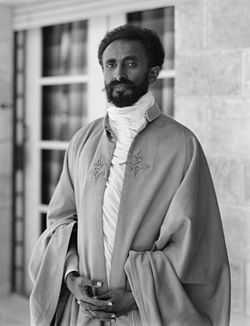Order of Solomon
| Order of Solomon | |
|---|---|
| | |
| Ribband of the order | |
| Award of Ethiopian Empire | |
| Type | Order presented to heads of state |
| Royal house | House of Solomon |
| Religious affiliation | Ethiopian Orthodox |
| Sovereign | Emperor of Ethiopia |
| Grades (w/ post-nominals) | Knight |
| Established | 1874 as part of Order of the Seal of Solomon 1922 as a separate order |
| Precedence | |
| Next (lower) | Order of the Seal of Solomon |

The Order of Solomon was an order of knighthood of the Ethiopian Empire.
The Solomonic dynasty, the ancient Imperial House of Ethiopia, claims descent from King Solomon and the Queen of Sheba, said to have given birth to King Menelik I after her visit to Solomon in Jerusalem.[1]
As the Empire's principal Order, it featured first in the long list of knightly titles of the last ruling Emperor of Ethiopia, Haile Selassie, described as –
The Lion of Judah Hath Prevailed (or "[by the] Conquering Lion of the Tribe of Judah");His Imperial Majesty Haile Selassie I, King of Kings of Ethiopia, Conquering Lion of Judah, Elect of God, Grand Cordon of the Order of Solomon, Knight Grand Cross of the Order of Solomon, Knight of the Garter, Knight Grand Cross of the Order of the Bath, Knight Grand Cross of the Order of St Michael and St George...[2]
.
Recipients
Recipients include Queen Elizabeth II, Dwight D. Eisenhower, King Haakon VII and King Olav V of Norway, the Emperor Akihito of Japan, and the Emperor Amha Selassie, last titular Emperor of Ethiopia.
Insignia
When the Emperor Yohannes IV awarded the Order to Admiral Sir William Hewett, c. 1884, it was described as "a gold triangular medal with six precious stones".[3]
References
- ↑ 1 Kings 10:1-10
- ↑ Ras Nathaniel, 50th Anniversary of His Imperial Majesty Emperor Haile Selassie (Trafford Publishing, 2004, ISBN 1-4120-3702-6) p. 5 at books.google.com
- ↑ Transafrican Journal of History (Makerere University Dept. of History, University of Nairobi Dept. of History, Chuo Kikuu cha Dar es Salaam Dept. of History East African Pub. House, 1986) p. 140